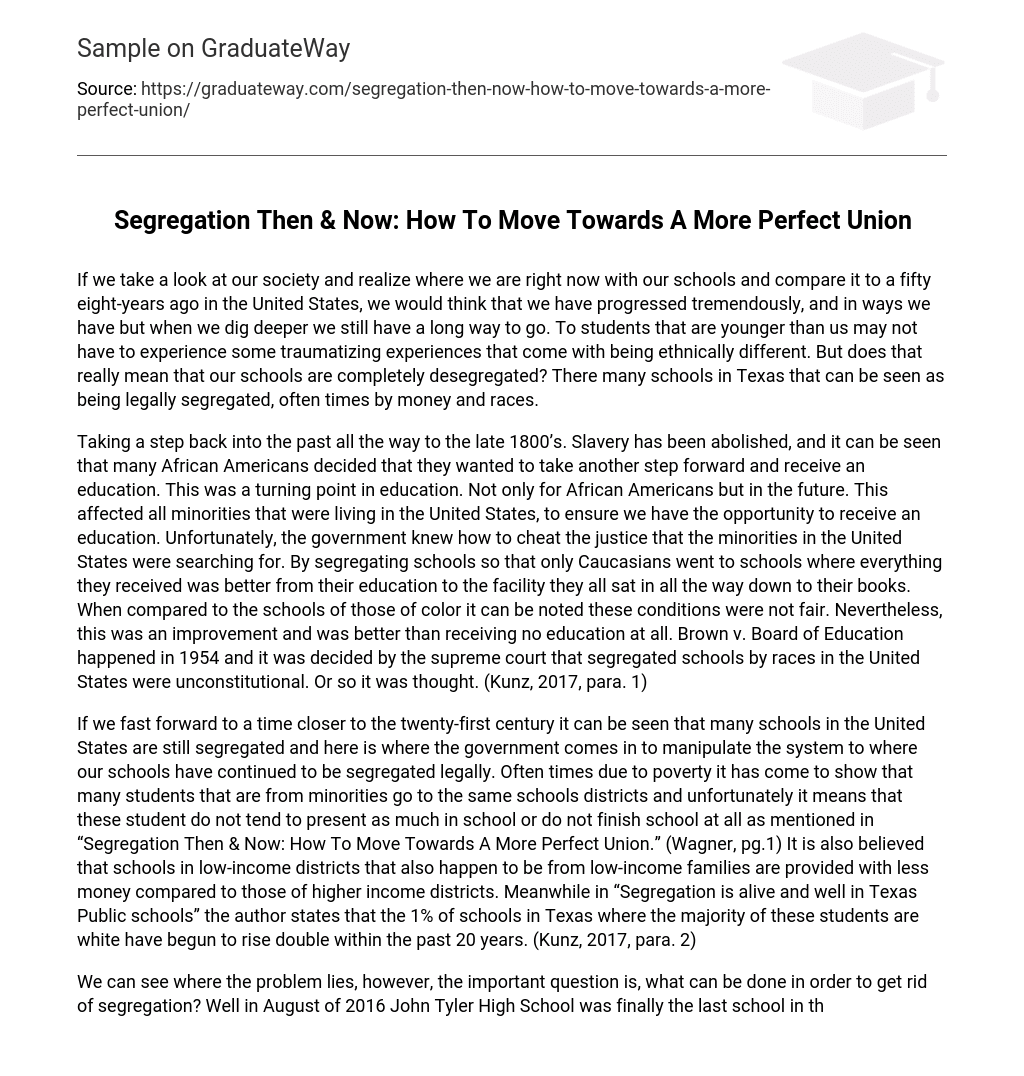If we take a look at our society and realize where we are right now with our schools and compare it to a fifty eight-years ago in the United States, we would think that we have progressed tremendously, and in ways we have but when we dig deeper we still have a long way to go. To students that are younger than us may not have to experience some traumatizing experiences that come with being ethnically different. But does that really mean that our schools are completely desegregated? There many schools in Texas that can be seen as being legally segregated, often times by money and races.
Taking a step back into the past all the way to the late 1800’s. Slavery has been abolished, and it can be seen that many African Americans decided that they wanted to take another step forward and receive an education. This was a turning point in education. Not only for African Americans but in the future. This affected all minorities that were living in the United States, to ensure we have the opportunity to receive an education. Unfortunately, the government knew how to cheat the justice that the minorities in the United States were searching for. By segregating schools so that only Caucasians went to schools where everything they received was better from their education to the facility they all sat in all the way down to their books. When compared to the schools of those of color it can be noted these conditions were not fair. Nevertheless, this was an improvement and was better than receiving no education at all. Brown v. Board of Education happened in 1954 and it was decided by the supreme court that segregated schools by races in the United States were unconstitutional. Or so it was thought. (Kunz, 2017, para. 1)
If we fast forward to a time closer to the twenty-first century it can be seen that many schools in the United States are still segregated and here is where the government comes in to manipulate the system to where our schools have continued to be segregated legally. Often times due to poverty it has come to show that many students that are from minorities go to the same schools districts and unfortunately it means that these student do not tend to present as much in school or do not finish school at all as mentioned in “Segregation Then & Now: How To Move Towards A More Perfect Union.” (Wagner, pg.1) It is also believed that schools in low-income districts that also happen to be from low-income families are provided with less money compared to those of higher income districts. Meanwhile in “Segregation is alive and well in Texas Public schools” the author states that the 1% of schools in Texas where the majority of these students are white have begun to rise double within the past 20 years. (Kunz, 2017, para. 2)
We can see where the problem lies, however, the important question is, what can be done in order to get rid of segregation? Well in August of 2016 John Tyler High School was finally the last school in that district that was finally beginning to desegregate thanks to a Federal Judge. Meanwhile, other schools in Texas are still fighting for it. (Bova, 2016, para. 1 & 2). Fortunately, Kunz’s article also gives us an insight into what Texas should start doing in order to minimize the rate of segregated schools. One of those being “zoning inclusively to provide affordable housing or desegregation busing in neighborhoods with high performing schools or equitable school funding.”(Kunz, 2017, para. 7) Even though desegregation might always come easy having the voice of a society is crucial. Wagner lets us know that even when school leaders want to desegregate their schools it’s often times out of their control, due to policies restricting them to do so. Therefore this is where society would come into play. Communities should have the right to have a say in any policy changes, especially if it has to do with the assignments of the students, and lastly, district leaders of homogenous communities should work with other leaders in order to make a plan to create diversity within their communities. (Wagner, pg.1)
Although there are certain groups that are in favor of desegregation, there are still those who don’t mind it and would rather keep it that way it is. An example of this would be when a white family moves into a neighborhood that is being gentrified they often check what type of races are in that school. And if the school has too many minorities for their liking they would rather put them in a private school, instead of integrating them. Which sets back the desegregation of schools.(Goldstein, 2016, para.2 & 3)
All in all desegregating schools is a difficult task to do since there are no official laws against it, in addition, those who want to live in a homogenous society will continue to pay in order to live that way. However, the world is slowly changing and can always improve. If parents and students in their communities worked together rather than just letting the injustice continue this could be stopped After All this is for our future generation.
Works Cited
- Bova, Gus, and Patrick Michels. “Some Texas Schools Are Still Fighting Desegregation Orders.” The Texas Observer, 30 Sept. 2016, www.texasobserver.org/school-desegregation-pi/.
- Goldstein, Dana. “What Do White Parents Want in Schools? A Lot of White Kids.” Slate Magazine, Slate, 15 July 2016, https://slate.com/human-interest/2016/07/when-white-parents-have-a-choice-they-choose-segregated-schools.html
- Kunz, Jacob. “Segregation Is Alive and Well in Texas’ Public Schools.” The Daily Texan, 1 Nov. 2017, 10:51 pm, www.dailytexanonline.com/2017/11/01/segregation-is-alive-and-well-in-texas%E2%80%99-public-schools.
- Wagner, Chandi. “ Segregation Then & Now: How To Move Towards A More Perfect Union.” Centerforpubliceducation.org, Jan. 2017, www.centerforpubliceducation.org/research/segregation-then-now.





